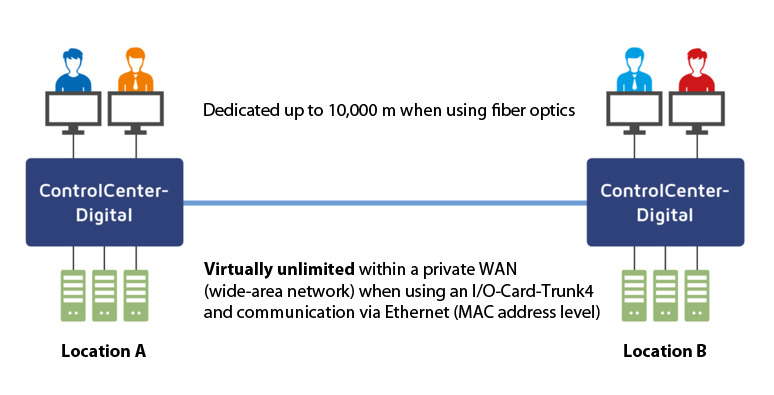G&D’s classic KVM systems use a proprietary G&D protocol to transmit signals. With dedicated cabling, you can bridge even distances up to 10,000 meters when using optical fibers.
Of course, there are applications where you need to cover even greater distances, such as when several remote locations want to use the same KVM system. This is where classic KVM systems with dedicated cabling are reaching their limits. Needless to say, G&D also provides solutions for such cross-location KVM applications. Various G&D devices can also communicate via Ethernet (MAC address level) and thus use an existing private WAN, i.e. existing network structures such as dark fiber.
I/O-Card-Trunk4: access KVM installations across locations

Our I/O-Card-Trunk4 is an all-rounder. For example, it comes in handy to reduce the amount of cable required when using a KVM matrix grid. You can place the card in one of the I/O slots of the ControlCenter-Digital.
In addition to dedicated connection options, the I/O-Card-Trunk4 is also Ethernet-capable, thus allowing you to use existing network structures. You can even set up KVM matrix installations across locations and large distances if suitable connections are available. Multi-user access from several locations is also possible.
Of course, you can also implement more complex installations across more than two locations.
IP extender systems and ControlCenter-IP with KVM-over-IP™
G&D also offers KVM extenders that enable access via IP structures.
IP extender systems use G&D’s KVM-over-IP technology to transmit signals. Thus, operators can access any connected computers over IP structures. Transmission is based on IP networks over gigabit Ethernet networks (OSI model layer 3) – even beyond subnetwork boundaries. Using additional control units (ControlCenter-IP), you can connect KVM installations of several locations.
- TOP 100 innovators – G&D among Germany’s most innovative mid-sized companies - 18. February 2021
- RemoteAccess-CPU – how to integrate virtual machines into your KVM matrix installation - 10. December 2020
- Key sets: how to operate your KVM installation even easier and faster - 17. September 2020


